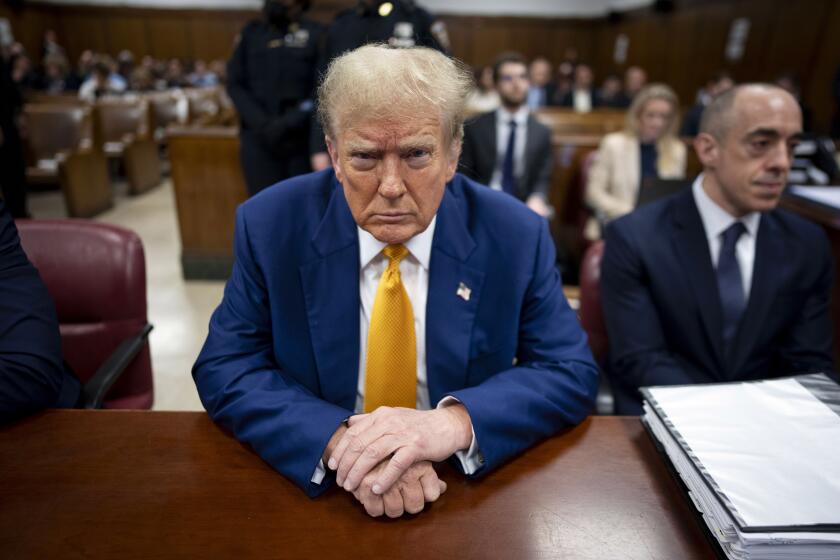Market Strikers Able to Limit Their Losses
Faced with a divided union leadership, relatively prosperous and determined supermarket owners, little public support and mixed feelings of their own, thousands of Southern California meat cutters, drivers and warehouse workers were badly bruised economically in the 55-day strike, which was finally settled on Sunday.
But, viewed as a “damage control” operation, the bitter, prolonged supermarket strike was, in fact, something of a success for the workers who had made almost no demands of their own and were primarily struggling to hold on to what they had.
The strikers forced management to drop several major contract demands that had already been accepted by members of the same unions in supermarkets in other parts of the country.
Nevertheless, the workers did lose some of their past gains and made almost none for the future. And so, in a broader sense, management’s success calls into question the “trickle-down” theory that President Reagan’s former budget director, David A. Stockman, once said is, in reality, the basic economic theory of the Administration.
Under the trickle-down theory, the economy--and the tax system--is structured so that the greatest gains go to the wealthiest individuals and the largest corporations. Their gains, in time, are supposed to trickle down to the general population because the system is expected to help make corporations profitable and create investment capital that can be used to create new jobs.
But there are more than 8 million Americans without jobs, and millions more are working only part time. And the “real” income (income after adjusting for inflation) is down for most workers. Thus, the trickle-down theory isn’t working for most of us.
So, the new supermarket contracts may help to increase the owners’ profits, which is the first part of the trickle-down theory. But the pacts are not even designed to make the rest of the theory work: They will not create new jobs, and they will mean lower wages for thousands of newly hired workers in the industry.
A better idea might be the equally old “trickle-up” theory, which calls for putting more money into the hands of workers, thus increasing their purchasing power and allowing them to buy more goods and services. Thus, more jobs are created and the economy is stimulated.
But corporate management generally seems to have the upper hand in labor relations these days, and there is little pressure to put the trickle-up theory into practice.
Instead, unions around the nation are fighting what are often losing battles just to hold their previous gains. And both union members and officers are divided on the most effective way to end what for millions of workers is an era of contract concessions that includes cuts or freezes in wages or one-time bonuses instead of permanent wage increases, two-tier wage structures and subcontracting union work to non-union companies.
The argument among workers and union leaders is when and how long to strike against management demands for contract concessions. That division was evident in the supermarket strike, primarily within the meat cutters’ union.
Management was getting mixed signals from top officials of the United Food & Commercial Workers, parent union of the meat cutters and local-level leaders. That fact may have prolonged the strike.
Some top officers of the international union, including, reportedly, UFCW President William Winn, had indicated to management early in the dispute that they might not oppose some form of a two-tiered wage structure that gives newly hired workers lower wages than those already on the payroll. Other UFCW locals elsewhere had already accepted the two-tier system.
At the same time, most Southern California UFCW local leaders were telling supermarket industry officials that neither they nor their members would ever accept such a system. Ultimately, compromises on both sides ended the bitter dispute.
The “damage control” successes of the Teamsters, representing drivers and warehouse workers, included, for instance, management’s agreement to drop the permanent two-tier wage system that the companies had demanded. Instead, the union accepted a “progression” wage structure that starts new workers at a lower rate but allows them to earn the same pay as experienced workers within three to five years.
However, the meat cutters’ union accepted a two-tier system that will give newly hired meat wrappers a starting wage of $5.53 an hour, about half that paid to currently employed wrappers who make up less than 10% of the membership. But the duties of the wrappers have been expanded, which, in time, will mean less work for journeymen butchers.
On the other hand, the experienced butchers fought off a two-tier system, but their guaranteed eight-hour day was reduced to four hours for newly hired butchers.
None of the workers won permanent pay raises, but they will get one-time bonuses of $500 this year and another $1,000 next year in lieu of a cost-of-living clause that ties wages to the inflation rate.
Thus, while the workers clearly didn’t win the strike, their “damage control” was better than expected. After all, the strike was costing the unions well over $2 million a week in strike benefits, the markets were not being badly hurt and other unions in the same industry elsewhere had accepted contract terms that the Southern Californians avoided.
Unfortunately, the strike didn’t help low or moderately paid workers, but it should increase corporate profits. Thus, the strike helped to prove that trickle down works better in theory than it does in practice.
More to Read
Get the L.A. Times Politics newsletter
Deeply reported insights into legislation, politics and policy from Sacramento, Washington and beyond. In your inbox three times per week.
You may occasionally receive promotional content from the Los Angeles Times.






